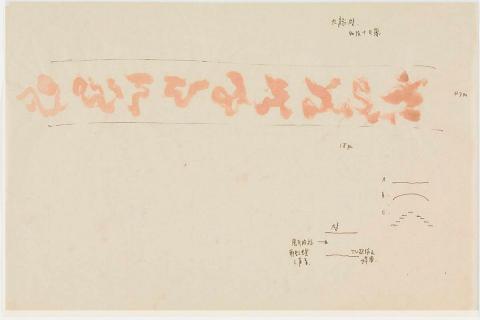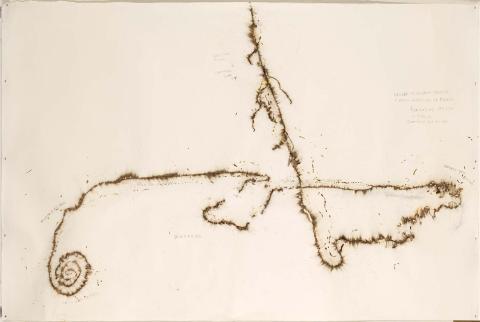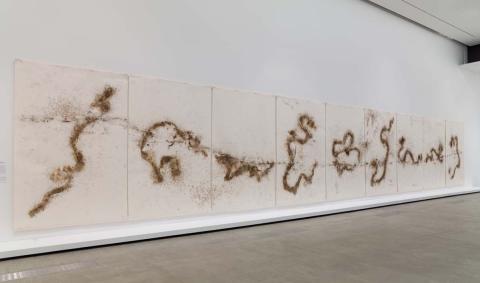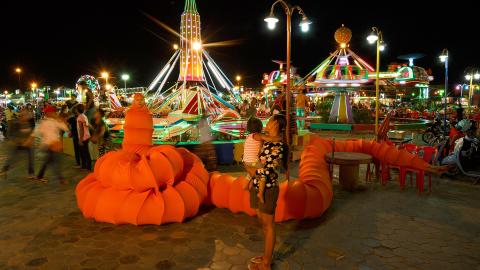APT2–3
The Asia Pacific Triennial of Contemporary Art
'The 2nd Asia Pacific Triennial of Contemporary Art' (APT2)
While the first Triennial looked at tradition and change — with the objective of bringing the past into the now — the second iteration of APT, in 1996, focused on the time at hand. The exhibition concept of ‘present encounters’ meant engaging the immediate present in the works themselves. Common themes emerged: history and memory, the revitalisation of traditions, religion and spirituality, issues of personal identity, questions of gender and sexuality, the natural environment, urban transformation, popular culture/counterculture/cultural iconoclasm, and assertion of local and cultural identities. In a comment to the Gallery during the exhibition, APT2 artist Nilima Sheikh said:
For the wonderfully efficient and caring organisation; for the warmth, hospitality and love, so generous and giving; and for filling up so many gaps in my understanding of my world — eternal gratitude.

A performance from PNG of the Roioipe mourning dance during the opening weekend of APT2, 1996 / © The artists / Photograph: QAGOMA

Takashi Murakami’s Mr DOB appeared as a helium balloon, as well as in the Collection work And then, and then and then and then and then 1994 (Purchased 1996. Queensland Art Gallery Foundation / © QAG), installed at QAG for APT2, 1996 / Photograph: QAGOMA
APT2 Highlights
A major highlight of APT2 was the inclusion of Mr DOB — one of the first-ever appearances of Takashi Murakami’s now iconic pop-culture character — in a sizeable diptych titled And then, and then and then and then and then 1994. We also welcomed to the Collection the substantial installation Problem-Wisdom 1993–95 by Kamin Lertchaiprasert, comprising 366 papier-mâché pieces. Cai Guo-Qiang’s gunpowder event Dragon or Rainbow Serpent: A Myth Glorified or Feared: Project for Extraterrestrials No. 28 1996 would have been a spectacular experience captured on film. Unfortunately, a disastrous fire at the fireworks factory destroyed all the Gallery's materials for the event; the explosive performance work, which would have rippled along the Brisbane River and surrounding infrastructure, couldn’t proceed.
APT2 included artists Cai Guo-Qiang, Zhang Xiaogang, Yun Suk-nam, Nalini Malani, Navin Rawanchaikul, Nilima Sheikh, SANGGAWA, Wong Hoy-Cheong, Destiny Deacon, Campfire Group, Fiona Hall, Lin Onus and more.

Cai Guo-Qiang’s Nine Dragon Wall (Drawing for Dragon or Rainbow Serpent: A Myth Glorified or Feared: Project for Extraterrestrials No. 28) 1996, installed at QAG for APT2, 1996 / Spent gunpowder and Indian ink on Japanese paper / Purchased 1996 / Collection: QAGOMA / © Cai Guo-Qiang / Photograph: QAGOMA
'The 3rd Asia Pacific Triennial of Contemporary Art' (APT3)
‘Beyond the Future: The Third Asia Pacific Triennial of Contemporary Art’, held in 1999, emphasised artists whose works cross boundaries between past and future, and between traditional and contemporary life. Exhibition projects with titles such as Crossing Borders, Virtual Triennial (the first APT website) and Journey without Maps saw interdisciplinary crossovers of visual art, music, popular culture and new technology. Many of the works in APT3 invited the audience to engage with them in unexpected ways. Xu Bing encouraged visitors to experiment with ink and brush in his New English Calligraphy classroom; while Lee Mingwei's Writing the Unspoken 1999 asked them to reflect on gratitude, insight and forgiveness as they composed letters to the living or the dead in three writing booths. The third Triennial also introduced programming specifically for children; with its matching mascot, Kids’ APT became an ongoing feature. Later iterations of this program, now called APT Kids, would tour the state with the support of the Tim Fairfax Family Foundation, bringing the exhibition’s activities and ideas to families in remote and regional areas.

Lee Wen during the filmed performance of his work Journey of a yellow man no.13: Fragmented bodies/shifting ground (detail) 1999 for APT3 / Videotape: 10:30 minutes, colour, stereo / Purchased 2000. Queensland Art Gallery Foundation / Collection: QAGOMA / © Lee Wen Estate / Photograph: Matthew Kassay, QAGOMA
APT3 Highlights
Cai Guo-Qiang explored the meeting of cultures with his Blue Dragon and Bridge Crossing 1999 across the main pool of the QAG Watermall, which enchanted visitors and spritzed those who crossed with a fine mist. The performance piece Journey of a yellow man no.13: Fragmented bodies/shifting ground 1999 took artist Lee Wen, painted head to toe in yellow, from a suburban Brisbane room into the city, past the Story Bridge, on a ferry, through the CBD, and across the Victoria Street Bridge to the steps of the Queensland Art Gallery. He carried a heart in his hands, which he laid open at the Gallery doors.
APT3 included artists Wilson Shieh, NS Harsha, Yee I-Lann, Michael Parekowhai, Mohammed Imran Qureshi, Alfredo and Isabel Aquilizan, Pinaree Sanpitak, Gordon Bennett, Guan Wei, Kumantye Jagamara, Sonabai, Ah Xian and more.

Cai Guo-Qiang’s Blue dragon & bridge crossing over the QAG Watermall during APT3 / Courtesy and © Cai Guo-Qiang / Photograph: Matthew Kassay, QAGOMA

The APT3 project Virtual Triennial featured the inflatable pink trees of Wang Jun-Jieh’s Neon urlaub – Agency vision 1997–99 / Courtesy and © Wang Jun-Jieh / Photograph: QAGOMA
Learn more

Digital Story Introduction
LOOKING BACK AT THE APT‘The First Asia Pacific Triennial of Contemporary Art’
Read digital storyDigital story context and navigation
LOOKING BACK AT THE APTExplore the story

Digital Story Introduction
LOOKING BACK AT THE APT‘The First Asia Pacific Triennial of Contemporary Art’
Read digital storyAbout this page
Related resources









